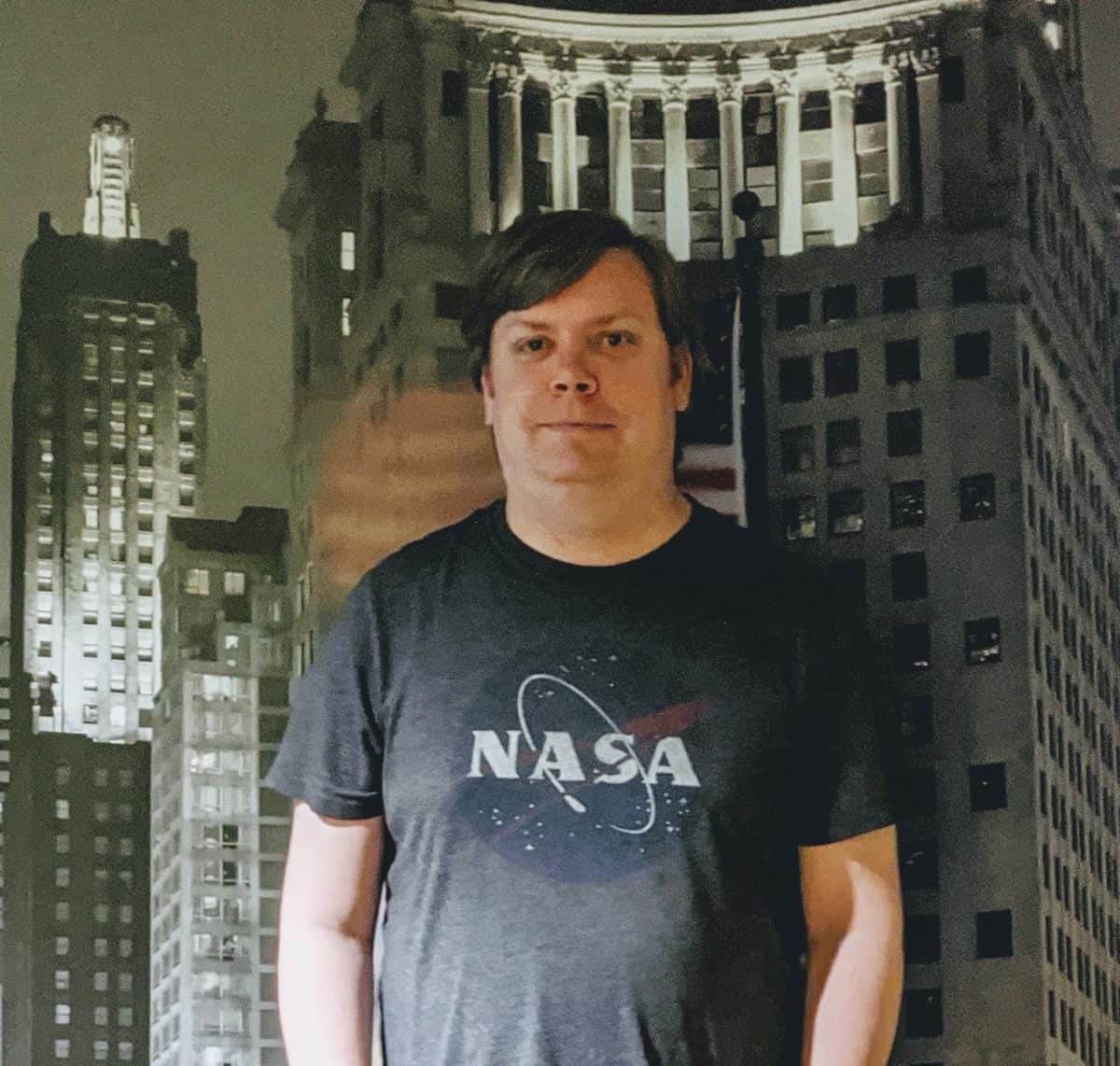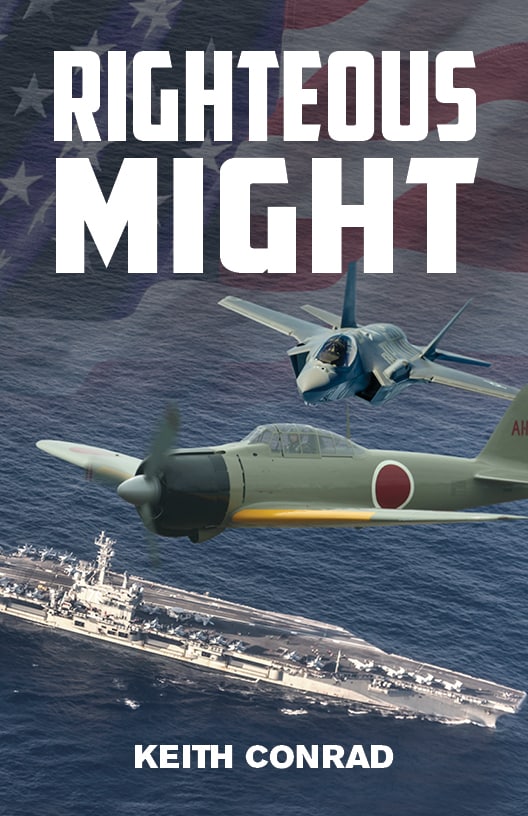Keith Conrad’s book Righteous Might is available for pre-order now at Eckhartz Press. It will ship in a few weeks. We caught up with Keith and discussed the launch of his book…

EP: I know the plot of this book is based on the plot of a movie that didn’t satisfy you as a kid. What was it about that original movie that bothered you?
Keith: I think I was seven or eight years old when I first saw the movie The Final Countdown. I always liked the film and I still think it’s a very good and thought-provoking story. However once I saw it again as an adult, a few things really stuck in my mind. First, the story follows a modern aircraft carrier that sails into a storm and suddenly finds itself in between the Americans and Japanese on the day before the attack on Pearl Harbor. Ultimately, that same storm re-appears and sends them back home before they can have a big impact on things. That all seemed a little too random for me and as someone who likes a good “What if?” scenario, I also always wondered what would happen if they actually did successfully enter the fight. I thought just about any way you could come up with for a modern supercarrier to show up in the past, it would be random enough that it should be a one-way trip. My biggest complaint about the story though was the fact that it followed a very small number of characters and as a result virtually none of the story spends any time examining what the crew would be going through in a situation like that. Most of the crew is unaware of what’s happening until very late in the story, but even when they find out what’s going on there is no time at all spent on their reaction in The Final Countdown. When I wrote this story I was excited to come up with a way to get the ship back in time, and I really liked the thought experiment of what impact the people from the future would have the attack on Pearl Harbor and afterwards in WWII and beyond. I was most excited by the idea of following the crews reaction to everything though. Both the people in command, and the people below decks who are in the dark for most of the story but know something is wrong.
EP: Time travel novels are tricky. There are so many implications you hadn’t considered yet when you began to write. What were a few of the time travel implications that struck you while you were writing, and how did that change the story (without giving too much of it away)?
Keith: I really wanted to take a deep dive into how the crew would react to that situation. I thought the most interesting part of the story was going to be the crew dealing with their sense of loss from being completely cut off from their family and friends and everyone they ever knew. That was more interesting to me then the fight with the attacking Japanese. That’s still the biggest part of the story, but I was really surprised at were the technological implications they would be dealing with right off the bat. I went into writing the story thinking the ships would have such a massive technological advantage over the Japanese from 1941 that it would not turn out to be much of a fight. In reality though, they’d actually be facing some pretty tough odds. It would be very tough for extremely difficult for them to contact the outside world immediately. There’s encryption with just about everything that the people in 1941 wouldn’t be aware of. Even talking on the radio would be a little like trying to run a VR simulation on a Commodore 64. So it’s not like they could easily warn Pearl Harbor as soon as they realized what was happening. Something that really surprised me was how much of an impact being cut off from the GPS network would have on the fleet. They would not be able to use most of their smart weapons without it, and even navigation would be very difficult. I think I came up with a clever, almost MacGuyver-like fix that gets them some of their gadgets back before they have to fight though, and I hope readers like it. It’s a lot for the crew to deal with though. They also have a lot of civilians under foot while all of this is happening. I decided to incorporate the Tiger Cruise element of the story because it really fascinated me to have the overwhelming majority of the crew facing the prospect of never seeing their family again while some of them actually have their family aboard the ship. It makes a complex and strange situation even more interesting. Once they are all aware of the situation, the crew is having to fix some pretty complex problems and invent new ways of going into combat at the same time they are dealing with the fact that most of them will never see their loves ones again. Plus, at the end story I would hope readers are thinking about the implications for the people from 1941. The presence of these people with their knowledge and technology is really going to change things.
EP: The details about the aircraft carrier and the chain of command were so believable I thought for sure you must have served some time in the Navy. Where did you research that, and how did you create such an authentic military environment?
Keith; Very early on in the process of writing the story I reached out to Captain James McGrath, who was teaching at the US Naval War College at the time. I gave him a rough idea of the story I wanted to tell and asked about what problems the fleet would run into in a situation like that and what their game plan would ultimately be. He gave me a ton of useful information about how things work on the technical side of things. One of the very early inspirations for starting this project was the PBS miniseries Carrier, which gave a lot of insight into what it’s like to serve on an aircraft carrier. It follows the USS Nimitz through an entire deployment, and I think it gave me a pretty solid idea of who all of the players are and how things work. I was a cadet in the Civil Air Patrol when I was a teenager, and that also probably helped me understand military chains of command. I have also been fortunate enough to cross paths with a few people over the years who have served on carriers and they were kind enough to chat with me pretty in depth about their experiences and what daily life is like on an aircraft carrier.
EP: Have you ever been to Pearl Harbor?
Keith: I have not actually been to Pearl Harbor personally. My mom and dad took a trip there several years ago however. Afterward when my dad was telling me the story of his visit to the USS Missouri and Arizona Memorial, he brought up the movie The Final Countdown, which got my brain thinking about the changes I thought that story could have used. Ultimately that led to me writing Righteous Might.
EP: In your day job, you’re a radio producer in Chicago. I recognized a lot of names of people in the Chicago broadcasting world in the character names. Are those characters tributes to the people named or is there another reason you did that?
Keith: There’s a story behind most of the names in the book. A couple of the character names were intended to be a tip of the cap to The Final Countdown and a bit of an Easter Egg for people who are fans of that movie. I also incorporated a few names of people I went to high school and college with who ultimately went on to serve in the military. Although ironically, none of those people actually served in the Navy. So I hope there aren’t any inter-branch rivalries stocked by their names showing up in the story. Matt Stoltz for example is someone I graduated high school with, and he is actually still currently serving in the Army. There are three people: Pete Fanning, Scott Tucker and Ernie Scatton, who served in the Navy and at various times during my writing process allowed me to pick their brains about what daily life is like on a carrier. Ernie and I also worked together in radio, but I added him as a character name because he was nice enough to talk with me about his time serving aboard the USS America. There are also plenty of radio people sprinkled in throughout the story though. Some are people I crossed paths with very early in my career. Darla Taylor was named after Darla Jaye, one of the first radio hosts I worked with when I was still in college. I also tried to throw in people I worked with behind the scenes like Scott Straus and Michael Garay. Mostly because they went above and beyond the call of duty listening to me complain on days when things weren’t working out particularly well.
EP: I know you are getting married soon. How hard has it been to plan a wedding during the COVID crisis, and how does your bride-to-be feel about her new husband becoming a published author?
Keith: Love in the time of COVID has been an interesting experience. Our wedding date ended up being right in the middle of the stay-at-home order in Illinois. We really wanted to keep that date though, so we just had to get a little creative to make things happen. We both have family and friends all around the country, so streaming the wedding online was always part of the plan anyway. Since the state is still under lockdown, we just canceled the in-person part completely and went with a completely virtual wedding and a party with all of our friends once we’re done dodging COVID and the murder hornets. Originally, we were going to stick with the same venue, but they backed out on us at the last minute causing another brief catastrophe. Luckily though, a hotel in our area was willing to help us out and allow us to do the stream from there and it actually ended up being a pretty swanky backdrop. The situation is not ideal, but we’ve both rolled with it pretty well. Even if we won’t have our family and friends with us there, it will still be an extremely memorable day. As for me becoming a published author, Misty tells me all the time that she’s very proud of me just for finally finishing the book. She is a very talented artist who is working on creating her own indie comic. It’s been a great experience to support her through that process while she supports my writing.

Leave a Comment